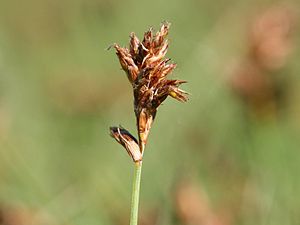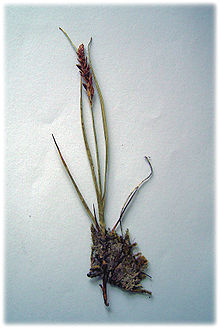Compressed spring rush
| Compressed spring rush | ||||||||||||
|---|---|---|---|---|---|---|---|---|---|---|---|---|

Compressed spring rush ( Blysmus compressus ) |
||||||||||||
| Systematics | ||||||||||||
|
||||||||||||
| Scientific name | ||||||||||||
| Blysmus compressus | ||||||||||||
| ( L. ) Panz. |
The Squeezed source bulrush ( Blysmus compressus ), also source ledges , swelling rush , Flat Quellried or Platthalm-Quellried , belongs to the genus of the source rushes ( Blysmus ) in the family of Cyperaceae (Cyperaceae).
description
Vegetative characteristics
The compressed spring rush is a perennial herbaceous plant . It forms underground runners ( rhizomes ). The upright or arching ascending stalks have a diameter of 0.5 to 1.5 millimeters in cross-section and are rounded and bluntly triangular towards the tip and reach a length of 6 to 40 centimeters. They grow, they have light to dark brown sheaths and are leafed at most to the middle.
The leaf blades are about 3 to 4 millimeters wide, gray to grass green, flat or hollow on the top, keeled on the underside, fleshy, rough on the edge and narrowed from the base. The tip is triangular in length. The leaf sheaths are closed and veined. The ligules are short and truncated.
Generative characteristics
The flowering period extends from May to September. At the end of the inflorescence a deciduous bract emerges , which usually clearly towers above the inflorescence. The brown, mostly dense, spiked inflorescence is 1 to 4 inches long and 8 to 12 millimeters wide and contains 5 to 18 spikelets arranged in two rows . The spikelets are lanceolate, 4 to 10 millimeters long and 2 to 3 millimeters wide and five to twelve flowered. The red-brown husks are elongated-lanceolate, pointed, five to seven-veined and about 4 millimeters long, 2 millimeters wide with a narrow green keel and a hyaline edge. The perianth consists of three to six rough bristles that are at least twice as long as the fruit. The flower contains three stamens and two stigmas .
The dark brown nut fruit is 1.5 to 2 millimeters long and obovate.
The number of chromosomes is 2n = 44.
Similar Art
A similar species is the red rush ( Blysmus rufus ). However, this has round, unkeeled leaves. The husks are chestnut brown. The inflorescence consists of up to three soft-haired inflorescence bristles.
ecology
The compressed spring rush is windblooded ( anemophilia ). Their diaspores are spread out by the wind ( anemochory ) and by Velcro spreading ( epichory ).
Occurrence
The compressed spring rush occurs in Europe , North Africa and Asia up to the Himalayas, but is largely absent in the extreme north. In the Alps, the compressed spring rush rises at altitudes of up to 2350 meters. In the Allgäu Alps, it rises in Vorarlberg on the Kuhgehrenspitze south of Riezlern up to 1900 meters above sea level.
The compressed spring rush is generally not common, regionally also rare. The species grows on swampy meadows , on lake shores and especially in disturbed areas of spring moors and in springy locations in extensive grassland . It also occurs on salt marshes . The compressed spring rush appears as a pioneer colonist in suitable locations without vegetation.
The ecological pointer values according to Ellenberg are: light number L 8 = half-light to full-light plant; Temperature number TX = indifferent; Continental number K 5 = showing lake / steppe transitional climate; Humidity number F 8 = humidity to wetness indicator; Change in humidity: showing no change in humidity; Reaction number R 8 = weak base to base / calcium indicator; Nitrogen number N 3 = indicating nitrogen poverty; Salt number S 1 = salt bearing, but mostly showing little or no salt content; Heavy metal resistance: not heavy metal resistant.
The compressed spring rush is a light plant . Their focus is on well-humid to soaked and air-poor, mostly chalky, low-nitrogen soils . Occasionally it occurs on salty soils.
Socialization
The compressed spring rush is one of the eponymous character species of the flat rush quellried society ( Blysmo-Juncetum compressi ; synonym: Blysmus compressus society ), which is highly endangered in Central Europe . Further characteristic species are the millet sedge ( Carex panicea ), Davall's sedge ( Carex davalliana ) and the narrow-leaved cotton grass ( Eriophorum angustifolium ). It also occurs as a companion in Kleinseggenrieden of the Davallseggen Society ( Caricetum davallianae ).
Hazard and protection
The compressed spring rush is safe worldwide and Europe-wide and does not enjoy any separate legal protection. In Germany, however, it is classified as highly endangered (hazard category 2). In Lower Saxony, Saxony, Hesse, Saarland, Hamburg and Berlin, the species is considered to be critically endangered. Their stocks suffer particularly from the drainage and intensification of use of their habitats. It is only somewhat widespread in the Alpine region.
Taxonomy
It was first published under the name ( Basionym ) Schoenus compressus in 1753 by Carl von Linné . The new combination to Blysmus compressus (L.) Panzer was published in 1827 by Georg Wolfgang Franz Panzer (1755-1829). Other synonyms for Blysmus compressus (L.) Panzer are: Scirpus planifolius Grimm , Scirpus caricinus Schrad. , Scirpus distichus Peterm. , Scirpus compressus (L.) Pers. non monks . The generic name Blysmus is derived from the Greek word blyzein for flow, based on the location, as they prefer species source locations. and specific epithet is derived from the Latin word compressus for compressed .
Systematics
One can distinguish the following subspecies and varieties:
- Blysmus compressus var. Brevifolius (CBClarke) Karth. : It occurs from southern Siberia to the Himalayas.
- Blysmus compressus subsp. compressus : It occurs from Europe to the Himalayas.
- Blysmus compressus var. Dissitus (Duthie) Karth. : It occurs in the western Himalayas.
- Blysmus compressus subsp. subulifolius A.P. Khokhr. : It occurs in Turkey.
literature
- Wolfram Schultze Motel: Scirpus. In: Gustav Hegi: Illustrated flora of Central Europe. 3. Edition. Volume II, Part 1, Paul Parey, Berlin / Hamburg 1980, ISBN 3-489-54020-4 , pp. 10-42. Heinrich Egon Weber (Hrsg.): Illustrated flora of Central Europe . Founded by Gustav Hegi. 2nd, completely revised and enlarged edition. Volume IV. Part 2C: Spermatophyta: Angiospermae: Dicotyledones 2 (4) (Rosaceae, 3rd part) . Parey Buchverlag, Berlin 2003, ISBN 3-8263-3065-X , p. 10-42 .
- Robert Anthony DeFilipps: Blysm. In: TG Tutin, VH Heywood, NA Burges, DM Moore, DH Valentine, SM Walters, DA Webb (eds.): Flora Europaea . Volume 5: Alismataceae to Orchidaceae (Monocotyledones) . Cambridge University Press, Cambridge 1980, ISBN 0-521-20108-X , pp. 280 (English, limited preview in Google Book Search).
- Eckehart J. Jäger, Klaus Werner (Ed.): Excursion flora from Germany . Founded by Werner Rothmaler. 10th edited edition. tape 4 : Vascular Plants: Critical Volume . Elsevier, Spektrum Akademischer Verlag, Munich / Heidelberg 2005, ISBN 3-8274-1496-2 .
Individual evidence
- ^ A b Robert Anthony DeFilipps: Blysm. In: TG Tutin, VH Heywood, NA Burges, DM Moore, DH Valentine, SM Walters, DA Webb (eds.): Flora Europaea . Volume 5: Alismataceae to Orchidaceae (Monocotyledones) . Cambridge University Press, Cambridge 1980, ISBN 0-521-20108-X , pp. 280 (English, limited preview in Google Book Search).
- ↑ a b Jürke Grau , Bruno P. Kremer, Bodo M. Möseler, Gerhard Rambold, Dagmar Triebel: Grasses. Sweet grasses, sour grasses, rushes and grass-like families in Europe (= Steinbach's natural guide ). New, edit. Special edition edition. Mosaik, Munich 1996, ISBN 3-576-10702-9 .
- ↑ a b c Blysmus compressus (L.) Panz. ex Link, Platthalm-Quellried. In: FloraWeb.de.
- ↑ Erhard Dörr, Wolfgang Lippert : Flora of the Allgäu and its surroundings. Volume 1, IHW, Eching 2001, ISBN 3-930167-50-6 , p. 223.
- ^ A b Heinz Ellenberg, HE Weber, R. Düll, V. Wirth, W. Werner, D. Paulißen: Pointer values of plants in Central Europe. Verlag Erich Goltze, 1992, ISBN 3-88452-518-2 . ( Scripta Geobotanica 18)
- ↑ Erich Oberdorfer: South German Plant Societies. Part I: Rock and wall communities, alpine corridors, water, silting and moor communities. 4th edition. Gustav Fischer, Jena / Stuttgart 1998, ISBN 3-437-35280-6 .
- ↑ a b c d e Rafaël Govaerts (Ed.): Blysmus compressus. In: World Checklist of Selected Plant Families (WCSP) - The Board of Trustees of the Royal Botanic Gardens, Kew . Retrieved August 19, 2018.
Web links
- Blysmus compressus (L.) Panz. ex Link, Platthalm-Quellried. In: FloraWeb.de.
- Compressed spring rush . In: BiolFlor, the database of biological-ecological characteristics of the flora of Germany.
- Profile and distribution map for Bavaria . In: Botanical Information Hub of Bavaria .
- Data sheet Blysmus compressus In: InfoFlora ( The national data and information center for Swiss flora ).
- Distribution in the northern hemisphere.
- Thomas Meyer: Data sheet with identification key and photos at Flora-de: Flora von Deutschland (old name of the website: Flowers in Swabia )
- Illustrations of the British Flora (1924).

